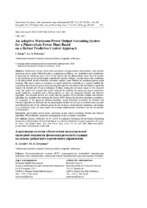An Adaptive Maximum Power Output Sustaining System for a Photovoltaic Power Plant Based on a Robust Predictive Control Approach

Date
2020Publisher
Another Title
Адаптивная система обеспечения максимальной выходной мощности фотоэлектрической станции на основе робастного прогнозного управления
Bibliographic entry
Elzein, I. An Adaptive Maximum Power Output Sustaining System for a Photovoltaic Power Plant Based on a Robust Predictive Control Approach = Адаптивная система обеспечения максимальной выходной мощности фотоэлектрической станции на основе робастного прогнозного управления / I. Elzein, Yu. N. Petrenko // Энергетика. Известия высших учебных заведений и энергетических объединений СНГ. – 2020. – № 5. – С. 441-449.
Abstract
Photovoltaic power plants have non-linear voltage-current characteristic, with specific maximum power point, which depends on operating conditions, viz. irradiation and temperature. In targeting the maximum power, it is by far known that the photovoltaic arrays have to operate at the maximum power point despite unpredicted weather changes. For this reason the controllers of all photovoltaic power electronic converters employ some method for maximum power point tracking. This paper makes an emphasis on model predictive controller as a control method for controlling the maximum power point tracking through the utilization of the well-known algorithm namely the Perturb and Observe technique. Further, during the advanced stages of this research study, the model will compare the results obtained for tracking the maximum power point from model predictive controller and a PID-controller as they are integrated Perturb and Observe algorithm. The obtained results will verify that the adaptive PID-controller Perturb and Observe algorithm has limitation for tracking the precise MPP during the transient insulation conditions. As compared to the proposed adaptive/modified model predictive controller for Perturb and Observe algorithm we illustrate that by adopting this method we will get to establish more accurate and efficient results of the obtained power in any dynamic environmental conditions: advantages as on regulation time (six times under the accepted experimental conditions) and by the number of fluctuations.
Abstract in another language
Фотоэлектрические станции (ФЭС) характеризуются нелинейной зависимостью выходного тока и напряжения с уникальной точкой максимальной выходной мощности (МВМ), зависящей от условий эксплуатации – температуры и уровня солнечной радиации. Поэтому для повышения эффективности фотоэлектрического преобразования необходимо обеспечить работу ФЭС в точке МВМ. Это достигается применением соответствующих алгоритмов управления, наиболее известными из которых являются P&O («возмущение и наблюдение»). Эти алгоритмы основаны на изменении напряжения постоянного тока ФЭС с помощью преобразователя постоянного тока (регулятора), выходное напряжение которого должно изменяться по определенному закону с изменением условий эксплуатации. При этом используются регуляторы: пропорциональные (П), интегральные (И), дифференциальные (Д) или чаще всего их комбинации ПИД. В статье исследуется эффективность применения регулятора с прогнозным адаптивным управлением (MPC). Посредством численных экспериментов на разработанной имитационной модели показано, что ПИД-регуляторы в интеграции с P&O и INC алгоритмами не обеспечивают достаточно быстрой реакции при изменении условий внешней среды. В то же время МРС в сочетании с P&O имеет преимущества как по времени регулирования (в шесть раз при принятых условиях эксперимента), так и по количеству колебаний.
View/
Collections
- № 5[7]
